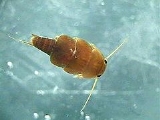
Peltoperlidae
Encyclopedia
Peltoperlidae Claassen 1931, also known as roachlike stoneflies or roachflies, are a family
of stoneflies
.
The family Peltoperlidae comprises 6 genera and 18 known species. Species are semivoltine, meaning that their life cycle is composed of 1 to 2 years. Adults of the family usually emerge in late spring or early summer, April through June. Larvae are flattened and brown in color, they are roachlike in appearance because of the expanded thoracic plates that cover the bases of the legs, head and abdomen. There are tapering gill
s on the thorax
at the bases of the legs
. These tracheal gills are multifunctional and key to many biological processes. There are no dense tufts or branching gills on the thorax or abdomen.
Peltoperlidae are generally lotic erosional and depositional. These habitats are flowing streams that are marked by sediment
s, vascular plant
s and detritus
. Roachlike stoneflies are generally found in leaf litter and debris piles either trapped in riffles or pools.
This family is considered to be clingers-sprawlers. This means that they attach to surface in erosional habitats or rest loosely on the top surfaces of substrates respectively. The body of this stonefly is flattened and streamline to aid in minimizing water resistance in a flowing stream.
Peltoperlidae are classified as in the feeding group shredders-detritivores. They chew and mine through leaf litter which is seen in their habitat. They are a significant contributor to leaf breakdown in streams. This family is very sensitive to disturbances in environmental conditions. They are intolerant to loss of coarse particulate organic matter for food and habitat.
The source of this article is wikipedia, the free encyclopedia. The text of this article is licensed under the GFDL.
Family (biology)
In biological classification, family is* a taxonomic rank. Other well-known ranks are life, domain, kingdom, phylum, class, order, genus, and species, with family fitting between order and genus. As for the other well-known ranks, there is the option of an immediately lower rank, indicated by the...
of stoneflies
Plecoptera
Plecoptera are an order of insects, commonly known as stoneflies. There are some 3,500 described species worldwide, with new species still being discovered. Stoneflies are found worldwide, except Antarctica...
.
The family Peltoperlidae comprises 6 genera and 18 known species. Species are semivoltine, meaning that their life cycle is composed of 1 to 2 years. Adults of the family usually emerge in late spring or early summer, April through June. Larvae are flattened and brown in color, they are roachlike in appearance because of the expanded thoracic plates that cover the bases of the legs, head and abdomen. There are tapering gill
Gill
A gill is a respiratory organ found in many aquatic organisms that extracts dissolved oxygen from water, afterward excreting carbon dioxide. The gills of some species such as hermit crabs have adapted to allow respiration on land provided they are kept moist...
s on the thorax
Thorax
The thorax is a division of an animal's body that lies between the head and the abdomen.-In tetrapods:...
at the bases of the legs
Arthropod leg
The arthropod leg is a form of jointed appendage of arthropods, usually used for walking. Many of the terms used for arthropod leg segments are of Latin origin, and may be confused with terms for bones: coxa , trochanter , femur, tibia, tarsus, ischium, metatarsus, carpus, dactylus ,...
. These tracheal gills are multifunctional and key to many biological processes. There are no dense tufts or branching gills on the thorax or abdomen.
Peltoperlidae are generally lotic erosional and depositional. These habitats are flowing streams that are marked by sediment
Sediment
Sediment is naturally occurring material that is broken down by processes of weathering and erosion, and is subsequently transported by the action of fluids such as wind, water, or ice, and/or by the force of gravity acting on the particle itself....
s, vascular plant
Vascular plant
Vascular plants are those plants that have lignified tissues for conducting water, minerals, and photosynthetic products through the plant. Vascular plants include the clubmosses, Equisetum, ferns, gymnosperms and angiosperms...
s and detritus
Detritus
Detritus is a biological term used to describe dead or waste organic material.Detritus may also refer to:* Detritus , a geological term used to describe the particles of rock produced by weathering...
. Roachlike stoneflies are generally found in leaf litter and debris piles either trapped in riffles or pools.
This family is considered to be clingers-sprawlers. This means that they attach to surface in erosional habitats or rest loosely on the top surfaces of substrates respectively. The body of this stonefly is flattened and streamline to aid in minimizing water resistance in a flowing stream.
Peltoperlidae are classified as in the feeding group shredders-detritivores. They chew and mine through leaf litter which is seen in their habitat. They are a significant contributor to leaf breakdown in streams. This family is very sensitive to disturbances in environmental conditions. They are intolerant to loss of coarse particulate organic matter for food and habitat.

